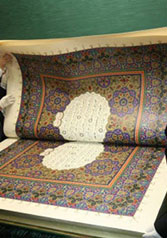Jonathan Franzen made headlines in January by announcing the he fears the effects of e-books. The acclaimed author of the novels,
Freedom and
The Corrections, both available as e-books, lamented digital texts' lack of permanence:
I think, for serious readers, a sense of permanence has always been part of the experience. Everything else in your life is fluid, but here is this text that doesn’t change.
“Will there still be readers 50 years from now who feel that way? Who have that hunger for something permanent and unalterable? I don’t have a crystal ball.
“But I do fear that it’s going to be very hard to make the world work if there’s no permanence like that. That kind of radical contingency is not compatible with a system of justice or responsible self-government.”
This blog has frequently documented the desire for the
preservation of cultures and values in the form of material books.













